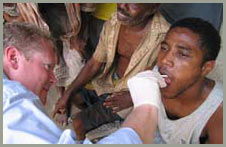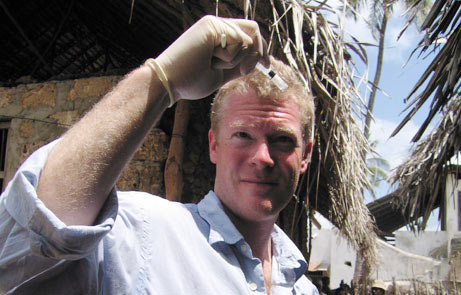Follow the trail of human legend
Genetic studies through DNA tests uncover the mysterious veil of human origin. It is possible that we are all relatives, separated by 2,000 generations.
Find Adam's DNA

Spencer Wells samples DNA from a person on Pate Island, in Kenya for the Genographic Project (Photo: nationalgeographic)
For many of us, the term " genetics " conjures up diseases, human genomes, and genetic engineering. But geneticist and anthropologist Spencer Wells thinks genetics is a unique career that combines his love of history and his passion for biology.
He traveled around the world, collecting blood samples from different ethnic groups in different cultures: Aboriginal people in Australia, residents of Siberia Chukchi permafrost, the peasants living among hills in Afghanistan, and nomadic people in the African deserts. By studying the DNA of modern people, he learns who we are, where we go to new parts of the world, and how close we are to all human relationships. . " Each drop of blood is a special historical document ," Wells said. "The DNA tells us the story of human migration."
The National Geographic Society has launched a five-year Genographic Project, headed by Spencer Wells, with the task of combining population genetics and molecular biology to trace it. of human migration from the time we first left Africa, 50,000 to 60,000 years ago, to the places where we live today.

The geneticist and geneticist Spencer Wells examines a DNA sample
(Photo: nationalgeographic)
Ten research centers around the world have received funding from the Waitt Family Foundation to collect and analyze blood samples from indigenous peoples, including many ethnic groups in remote areas. The genetic geographic project hopes to collect more than 100,000 DNA samples to create the world's largest gene bank. The project will show the paths that prehistoric people have gone to reproduce across the ground, drawing a picture of the genomic carpet that connects us all.

Hadzave tribe living nomadic in northern Tanzania hope that participation
their participation in the Genetic Geographic Project will help draw attention to cultural heritage
their threat (Photo: nationalgeographic)
Adventures of genes
As often happens in science, technology has opened up a field with new ways to answer old questions, and often gives us startling answers.
By analyzing genetic changes in the human Y chromosome in every region of the world, Wells and colleagues concluded that all human beings living on earth today are descendants of one single African people. (Scientists base on Y chromosome because it is one of the most powerful at the cellular level, tracing the origins of humanity - transmitting from father to son without changing throughout the thousands. year).

Advanced computer technology used to replicate the portrait of Adam - human ancestors (Photo: nationalgeographic)

The face of a computer-generated Adam model (Photo: nationalgeographic)
In his book, The Journey of Man: The Journey of Man (The journey of man: A genetic Odyssey), Wells describes the migration from Africa beginning about 60,000 years ago, and the path they I went to bring people everywhere in the world. Following the southern Asian coastline, the first migrants passed about 250km of sea, and occupied Australia about 50,000 years ago. Australian Indians, the descendants of the first wave of migration from Africa.
A second wave of leaving the " black continent " was about 45,000 years ago and settled in the Middle East, with smaller groups going to India, northern China, and southern China. When the Ice Age glaciers began to melt around 40,000 years ago, and the temperature increased, people moved into Central Asia and quickly grew there. Small groups left Central Asia about 35,000 years ago to reach Europe. And about 20,000 years ago, a small group of other Central Asians went further north, to Siberia and the Arctic.

Adam statue is molded in 3D model of the computer (Photo: nationalgeographic)
The story of Genghis Khan
In another study examining blood samples collected over a period of 10 years from more than 40 groups of people living in the vicinity of the Mongolian kingdom of the famous great Khan, Genghis Khan (Genghis Khan), Wells and colleagues found that nearly 8% of people living in the region have similar Y chromosomes, corresponding to 0.5% of men in the world or nearly 16 million people.

The famous Journey of Man: The Journey of Man: A Genetic Odyssey by Spencer Wells (Photo: Amazon)
The kingdom map of Genghis Khan in the 13th century stretches from Mongolia to Afghanistan and from Russia down to Iran, extending throughout Asia, from the Pacific to the Caspian Sea. What Genghis Khan accomplished was not only to rule the largest empire in the world, but also to increase the population in places where his prairie horses passed.
Every time a castle was conquered, the emperor's conquest on this horse often ended with slaughtering all the defeated, straightforwardly recovering the enemy's legacy, eradicating many nations. . Genghis Khan allowed soldiers under his power to loot but ordered his subordinates to pay good girls for his sexual gratification or to add to his squadron.
After more than 40 years of war, Genghis Khan died at age 65. At that time, the map of the Mongol empire stretched from the Chinese coast to the Persian Gulf. Within the next few hundred years, the descendants who continued the career of this belligerent master also continued to " promote the family tradition ", with the expansion of the kingdom, maintaining power in new lands, At the same time, he also tried to " spread the race ". The descendants of Genghis Khan perform harem regimes with countless wives, and therefore, every man often gives birth to many children. The son of Genghis Khan, Tushi, is credited with up to 40 sons. Grandchildren of Genghis Khan, Kublai Khan, have 22 official sons, not to mention the harem is supplemented with 30 virgins every year .
It was the descendants of the Mongol empire who circulated his father's lineage everywhere, directly contributing to the expansion of the Khan family, helping him become the " most successful sow in history ". Spencer Wells said: "This is a good example of how culture plays a major role in the distribution of genetic diversity in populations".
Ngan Giang
EATING BY SCIENCE
Information " About 16 million men around the world who may be descendants of Genghis Khan " have suggested the business idea for Shish in north London to specialize in Central Asian and Middle Eastern specialties. . All diners have the opportunity to try DNA genetics to see if they belong to Genghis Khan's lineage. The restaurant staff will take a sample of saliva inside the cheek of the person who wants to be tested and send it to the Oxford Ancestors DNA Test Company for testing. Results will be returned within two months. If you are determined to be a descendant of Genghis Khan's lineage, you will receive free meals for 2 return meals at the Shish restaurant.

Genghis Khan is the " most successful breeder in history ".
(Photos: Wikipedia)
- The Great Flood - Legend and science
- Inca trail
- Legend of Beowulf legend
- The great trail of the Inca empire
- Corel adds Microsoft OpenXML support
- Video: Giant carnivorous alligator in America
- Go to the forest, frightened to meet beasts
- Nga god snake
- Mountain bear legend
- 5 magical lands in world famous legend
- What is the legend of zombies and vampires?
- Video: Explore the most dangerous trail in the world
 'Fine laughs' - Scary and painful torture in ancient times
'Fine laughs' - Scary and painful torture in ancient times The sequence of numbers 142857 of the Egyptian pyramids is known as the strangest number in the world - Why?
The sequence of numbers 142857 of the Egyptian pyramids is known as the strangest number in the world - Why? History of the iron
History of the iron What is alum?
What is alum?